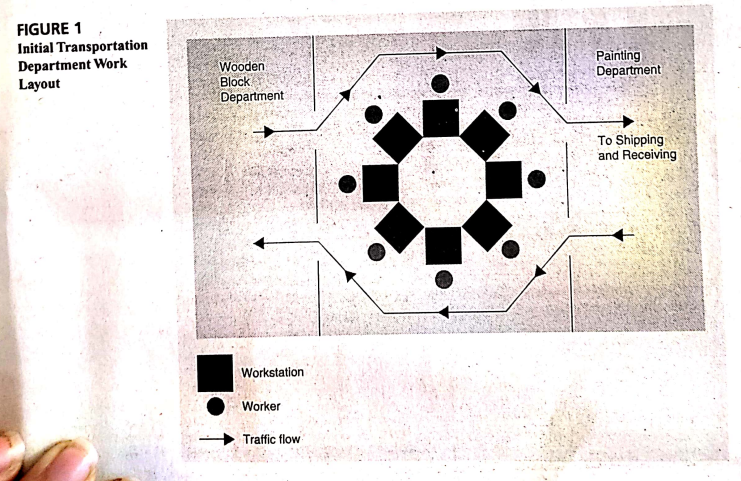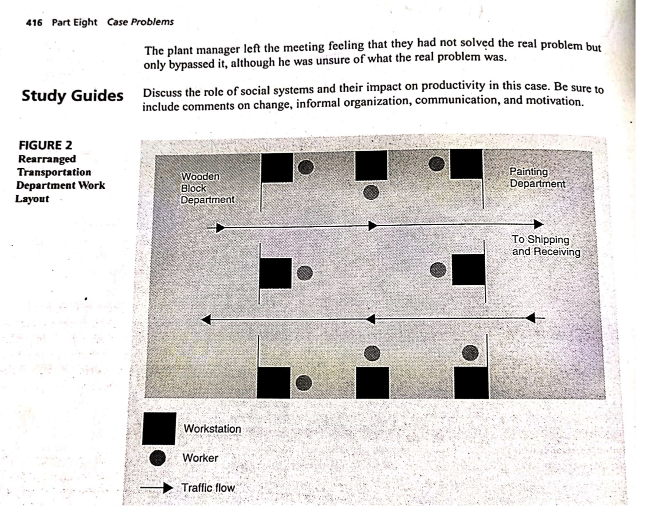Discuss the role of social systems and their impact on productivity in this case. Be sure to include comments on change, informal organization, communication, and motivation.
Read the case:
The Creative Toys Company, a small firm that specializes in producing small wooden toys, was started by John Wilson. A carpenter by hobby, Mr. Wilson had made numer- ous toys for his children. He found these toys to be quite marketable in an age of plastic, battery-operated, easily broken toys. The company is proud of its history and stability and growth in the industry. Low turnover rates are the result of good wages and fringe benefits.
One department in particular had been highly productive. The transportation department at one time surpassed all other departments in production for 12 months. The only reason for this success is the low turnover rate within the department. All eight people in the de- partment have held their current jobs for at least two years.
This department is responsible for producing all the toy cars and trucks in the firm's product line. Each department member has all the tools and equipment at his or her work- station to produce a complete toy. Four workers make cars in the morning while the other four produce trucks. The system is reversed in the afternoon to decrease monotony.
In the past, upper management allowed each department to determine its own procedure and methods, as long as production orders were filled on time. This departmental autonomy allowed the transportation department to rearrange its eight work areas in a circular fashion (see Figure 1). This circular arrangement let the department members converse with each other and keep informed of each other's work habits and productivity. They not only were high producers but also got along well outside of work.
The plant manager recently decided to bring in consultants to determine if produc- tion could be increased without physical expansion; demand for company products had outstripped production capacity. One recommendation dealt with the transportation department. The physical layout of the department did not facilitate efficient traffic flow to and from the other departments. The transportation department was located between the painting department and the wooden block department. Supplies and com- pleted products were placed in a storage area in the shipping and receiving depart- ment, creating considerable traffic through the departments. One employee on a forklift would bring supplies to all the departments and simultaneously remove the completed products.
The consultants recommended rearranging the work areas in the transportation depart- ment into eight individual areas to facilitate traffic flow (see Figure 2). In their report the consultants viewed the department's productivity as having the potential for substantial improvements. The plant manager agreed with the assessment and had the workstations rearranged during the next weekend.
After two months it was obvious that the transportation department's productivity was declining. The plant manager spoke to all members of the department, hoping to find some answers; however, department members could not articulate the problem. They knew only that something had changed besides the physical arrangement of the work areas.
Mr. Wilson asked the plant manager for an explanation of the department's declining productivity.
Plant Manager: I see no obvious reason for this decline. The department is com- posed of the same people, doing the same work. The only difference is the work area layout, and the workers seem to have adapted well. Perhaps a raise is the answer. In the past this department put out more than the other departments. Monetary recognition could be the answer.
Mr. Wilson: We have done some rearranging in other, more unstable departments. These other departments have increased productivity; that suggests to me that the re- arrangement is not the problem. I think the department must have built in slack time on purpose. The workers want a raise, and this is their way of getting our attention. I won't be blackmailed this way! They'll not get raises until they have met their prior production performance.
The plant manager left the meeting feeling that they had not solved the real problem but only bypassed it, although he was unsure of what the real problem was.
Study Guide:
Discuss the role of social systems and their impact on productivity in this case. Be sure to include comments on change, informal organization, communication, and motivation.


Step by step
Solved in 4 steps









